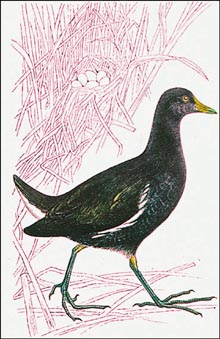Who says hens
are bird-brained?
By Nutan
Shukla
IN the animal world, the female
usually chooses a mate who is not only stronger than her
but also stronger than the other males of the group.
However in the case of moorhen, also known as common
gallinules, the case is different. It is surprising that
the females of these birds select males who are
physically inferior to herself for mating.
 According
to experts the females of this monogamous bird play a
very aggressive and dominant role and select small males
as they need less food to keep healthy and can put on
comparatively more fat. Such males can devote more time
to incubation because they will need less time to feed.
This enables the female to spare more time for laying
more eggs at different places to make good the losses of
eggs by predation which is very high in these birds as
they are mainly ground-nesting birds. According
to experts the females of this monogamous bird play a
very aggressive and dominant role and select small males
as they need less food to keep healthy and can put on
comparatively more fat. Such males can devote more time
to incubation because they will need less time to feed.
This enables the female to spare more time for laying
more eggs at different places to make good the losses of
eggs by predation which is very high in these birds as
they are mainly ground-nesting birds.
Moorhens are prolific
breeders and they usually raise two to three broods of
six to ten chicks every season. Despite the fact that
they handle such a large number of nestlings they take
full care in raising them. In the beginning of the season
the rate of predation is very high so to deal with it,
moorhens resort to laying eggs repeatedly as well as
‘dump nesting’ (where more than one females
have laid in the same nest). The chicks are very active
and leave the nest within two to three days and are soon
able to swim and dive. In moorhens, not only do both
parents share the duty of incubation and feeding the
young, but the elder siblings (young of an earlier
brood), too feed their young brothers and sisters..
The moorhen is the most
common of all the gallinules and is found on every
continent, except the southern Pacific islands and
Australia. It is often found in the same areas as coots
but it is slightly smaller than it and is also easily
distinguished from the coot because of the bright red
frontal shield. Apart from this, its under-tail is white
which is flashed by the bird during courtship displays.
Rails who are also
members of the same family, Rallidae, as moorhens,
include species which have become rare in last few
decades. For instance, guam rail is an extremely rare
bird. Among the eight of the world’s total number of
species of rails which are threatened, guam rail is the
only species whose entire population (mere 33 birds in
1986) is confined to captivity.
Decline in their number
on such a large scale is attributed to the Australian
brown tree snake and the rat snake of Philippines which
were introduced to Guam during the World War II. Reptiles
preyed mainly on these birds and their eggs, which were
laid either on the ground or in a low bush. Other factors
which played a significant role in pushing the bird to
the verge of extinction were disappearing marshlands,
human disturbances and introduced competitive domestic or
predatory animals.
The bird is named after
the place where it is found. Guam is situated in pacific
lying in-between Japan and New Guinea. It is a territory
of USA.
Inaccessible Island rail
is the smallest flightless bird in the world. Found on
the remote Inaccessible Island, in South Atlantic, this
bird measures 12.5 cm and weighs about 35 gms only. In
appearance, this flightless bird is no larger than a
newly-hatched chicken and spends most of its time in
burrows or among the tussock grass which is found in
abundance on the island.
Restricted to New
Zealand is another species named takahe which is also an
extremely rare flightless bird. It is also the biggest
and the heaviest of all members of the rail family.
Weighing 3.5kg takahe is a very colourful bird with a
frontal shield and a broad red bill.
For some time it was
lost to the civilized world, but was rediscovered in the
mountainous terrain of New Zealand’s South Island in
the year 1948. Prior to this it was last seen in the year
1898, and was thought to have been extinct.
Other members of the
family are coots. The horned coot a rare bird confined to
lakes high in the Andes mountains of South America, have
a muscular wattle on the forehead while the other species
have yellow, red to white patch, called frontal shield,
making the bird look as though it is going bald. The
expression "bald as coot" used to describe bald
people is taken from these birds.
|

